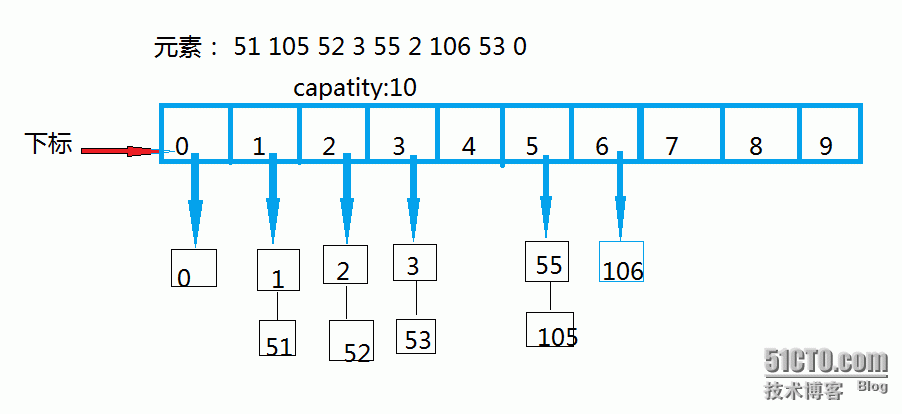上篇博客我寫的是用線性探測來解決哈希表。http://10739316.blog.51cto.com/10729316/1771958
下面我在介紹另一種解決哈希表的方法,開鏈法,也叫哈希桶。下面我介紹一下這種方法的思路。
基本思路:
1.先給一個數組,這個數組中存的是指針數組,每個指針數組都指向一個數組。
2.用元素除以存儲指針數組的數組的大小。
3.餘數與指針數組下標相同的,都鏈到數組指針指向的這一個數組。
我在進一步用圖表示一下:
HashTable.h中
#pragma once
#include <vector>
template<class K,class V>
struct HashTableNode
{
K _key;
V _value;
HashTableNode* _next;
HashTableNode(const K& key, const V& value)
:_key(key)
, _value(value)
, _next(NULL)
{}
};
template <class K,class V>
class HashTable
{
typedef HashTableNode<K, V> Node;
public:
//拷貝構造
HashTable()
:_table(NULL)
, _size(0)
{}
//拷貝構造
HashTable(const HashTable<K,V>& ht)
{
_table.resize(ht._table.size());
for (int i = 0; i < ht._table.size(); i++)
{
Node* cur = ht._table[i];
while (cur)
{
Node* tmp = new Node(cur->_key, cur->_value);
tmp->_next = _table[i];
_table[i] = tmp;
_size++;
cur = cur->_next;
}
}
}
//賦值運算符的重載
HashTable<K, V> operator=( HashTable<K, V> ht)
{
if (this != &ht)
{
swap(_table, ht._table);
swap(_size, ht._size);
}
return *this;
}
//析構函數
~HashTable()
{
if (_table.size())
{
for (int i = 0; i < _table.size(); i++)
{
Node* cur = _table[i];
while (cur)
{
Node* del = cur;
cur = cur->_next;
delete del;
del = NULL;
}
}
}
}
bool Insert(const K& key, const V& value)
{
//是否需要擴容
if (_size == _table.size())
{
_ExpandCapatity();
}
size_t index = _HashFunc(key);
Node* cur = _table[index];
//防冗餘
while (cur)
{
if (cur->_key == key)
{
return false;
}
cur = cur->_next;
}
//插入節點
Node* tmp = new Node(key, value);
tmp->_next = _table[index];
_table[index] = tmp;
_size++;
return true;
}
Node* Find(const K& key)
{
size_t index = _HashFunc(key);
Node* cur = _table[index];
while (cur)
{
if (cur->_key == key)
{
return cur;
}
cur = cur->_next;
}
return NULL;
}
bool Remove(const K& key)
{
size_t index = _HashFunc(key);
Node* cur = _table[index];
Node* prev = NULL;
//找到要刪除的元素
while (cur)
{
if (cur->_key == key)
{
break;
}
prev = cur;
cur = cur->_next;
}
if (cur)
{
//頭刪
if (cur == _table[index])
{
_table[index] = cur->_next;
}
//刪除中間元素
else
{
Node* next = cur->_next;
prev->_next = next;
}
delete cur;
cur = NULL;
_size--;
return true;
}
return false;
}
void Print()
{
for (int i = 0; i < _table.size(); i++)
{
Node* cur = _table[i];
cout << i << ":";
while (cur)
{
cout << cur->_key << " ";
cout << cur->_value << " ";
cur = cur->_next;
}
if (_table[i] == NULL)
{
cout << "NULL";
}
cout <<endl;
}
cout << endl;
}
protected:
//算出應該鏈接到哈希桶的那個位置
size_t _HashFunc(const K& key)
{
return key%_table.size();
}
//新的容量
size_t _NewSize()
{
// 使用素數表對齊做哈希表的容量,降低哈希衝突
const int _PrimeSize = 28;
static const unsigned long _PrimeList[_PrimeSize] =
{
53ul, 97ul, 193ul, 389ul, 769ul,
1543ul, 3079ul, 6151ul, 12289ul, 24593ul,
49157ul, 98317ul, 196613ul, 393241ul, 786433ul,
1572869ul, 3145739ul, 6291469ul, 12582917ul, 25165843ul,
50331653ul, 100663319ul, 201326611ul, 402653189ul, 805306457ul,
1610612741ul, 3221225473ul, 4294967291ul
};
for (int i = 0; i < _PrimeSize; i++)
{
if (_PrimeList[i]>_table.size())
{
return _PrimeList[i];//按照素數表來設置容量大小
}
}
//當需要的容量超過素數表的最大容量,我們就按照最大的來擴容
return _PrimeList[_PrimeSize - 1];
}
//哈希桶擴張容量
void _ExpandCapatity()
{
//開闢一個新的更大容量哈希桶
size_t newsize = _NewSize();
vector<Node*> newtable;
newtable.resize(newsize);
//把原來哈希桶中的元素再下來,插入到新的哈希桶
for (int i = 0; i < _table.size(); i++)
{
Node* cur = _table[i];
while (cur)
{
Node* tmp = cur;
int index = _HashFunc(tmp->_key);
//頭插法
tmp->_next = newtable[index];
newtable[index] = tmp;
cur = cur->_next;
}
_table[i] = NULL;
}
_table.swap(newtable);
}
protected:
vector<Node*> _table;
size_t _size;//數據的多少
}; 爲了減少哈希衝突,我擴張容量是用到了素數表。你們如果想問我爲什麼用素數表能減少哈希衝突,其實我也不知道,我只是知道別人這樣說,我拿來用而已。
//新的容量
size_t _NewSize()
{
// 使用素數表對齊做哈希表的容量,降低哈希衝突
const int _PrimeSize = 28;
static const unsigned long _PrimeList[_PrimeSize] =
{
53ul, 97ul, 193ul, 389ul, 769ul,
1543ul, 3079ul, 6151ul, 12289ul, 24593ul,
49157ul, 98317ul, 196613ul, 393241ul, 786433ul,
1572869ul, 3145739ul, 6291469ul, 12582917ul, 25165843ul,
50331653ul, 100663319ul, 201326611ul, 402653189ul, 805306457ul,
1610612741ul, 3221225473ul, 4294967291ul
};
for (int i = 0; i < _PrimeSize; i++)
{
if (_PrimeList[i]>_table.size())
{
return _PrimeList[i];//按照素數表來設置容量大小
}
}
//當需要的容量超過素數表的最大容量,我們就按照最大的來擴容
return _PrimeList[_PrimeSize - 1];
}
//哈希桶擴張容量
void _ExpandCapatity()
{
//開闢一個新的更大容量哈希桶
size_t newsize = _NewSize();
vector<Node*> newtable;
newtable.resize(newsize);
//把原來哈希桶中的元素再下來,插入到新的哈希桶
for (int i = 0; i < _table.size(); i++)
{
Node* cur = _table[i];
while (cur)
{
Node* tmp = cur;
int index = _HashFunc(tmp->_key);
//頭插法
tmp->_next = newtable[index];
newtable[index] = tmp;
cur = cur->_next;
}
_table[i] = NULL;
}
_table.swap(newtable);
} 希望自己的理解能幫到大家,如果有什麼錯誤,希望大家及時提出,謝謝!

